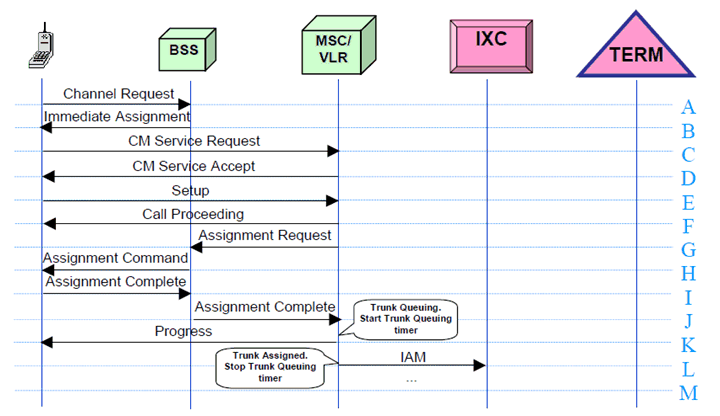Content for TR 22.952 Word version: 18.0.1
0…
4…
4.8…
5
5.1
5.2
5.3
5.4
5.5
5.6
5.7
5.8
5.9
5.10
5.11
5.12
5.13
6…
A…
B
B.1
B.2
B.3
B.4
B.5
B.6
B.7
B.8
B.9
C
D…
5.11 Priority service call progression - MSC - outgoing trunk queuing p. 29
This clause illustrates the call flow for call progression for a Priority Service call with trunk queuing at the originating MSC.

A-J.
The required steps that follow are the same as described in steps L-P of Clause 5.1.
Same as described in steps A-J of Clause 5.1.
K.
On receipt of the Assignment Complete message, the MSC/VLR scans through all trunk groups in the route list for an idle trunk. As no idle outgoing trunk is available on receipt of the Assignment Complete message, the MSC/VLR places the call in an outgoing trunk queue based on a First-In, First-Out basis and starts the trunk queuing timer. The MSC/VLR then sends a Progress message to the MS. The Progress message includes the progress indicator information element with progress description set to #64 "Queuing". On receipt of the Progress message, the MS stops all CC timers related to the call, including CC timer T310.
L.
When an idle outgoing trunk becomes available before the trunk queuing timer expires, the MSC/VLR removes the call from the outgoing trunk queue, stops the trunk queuing timer, and sends an ISUP IAM message to the succeeding switch. The MSC/VLR starts ISUP IAM timer T7. The ISUP IAM message includes the Calling Party's Category parameter set to the IEPS call marking for preferential call set up and the Precedence parameter set based on the initiating Service User's priority level.